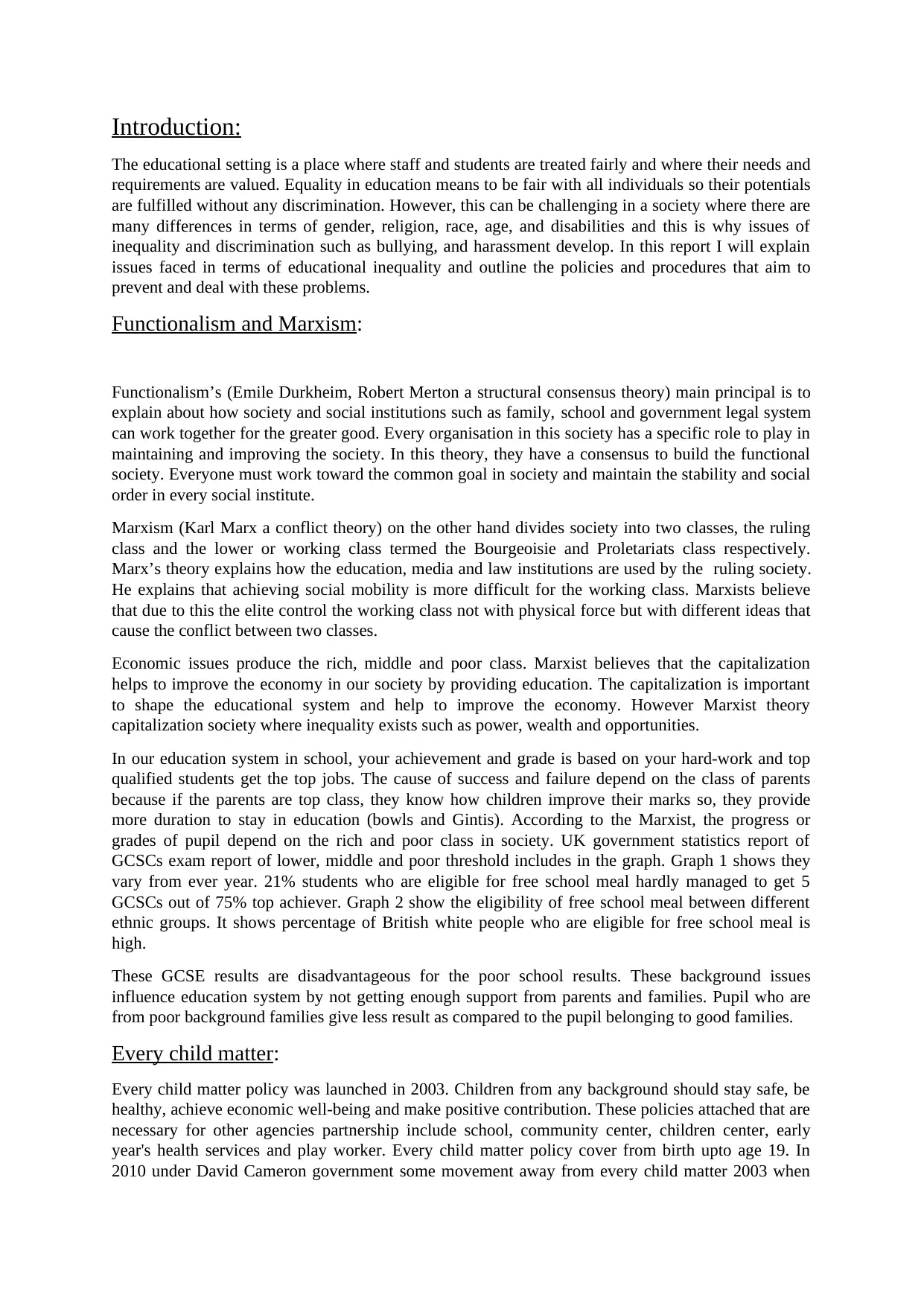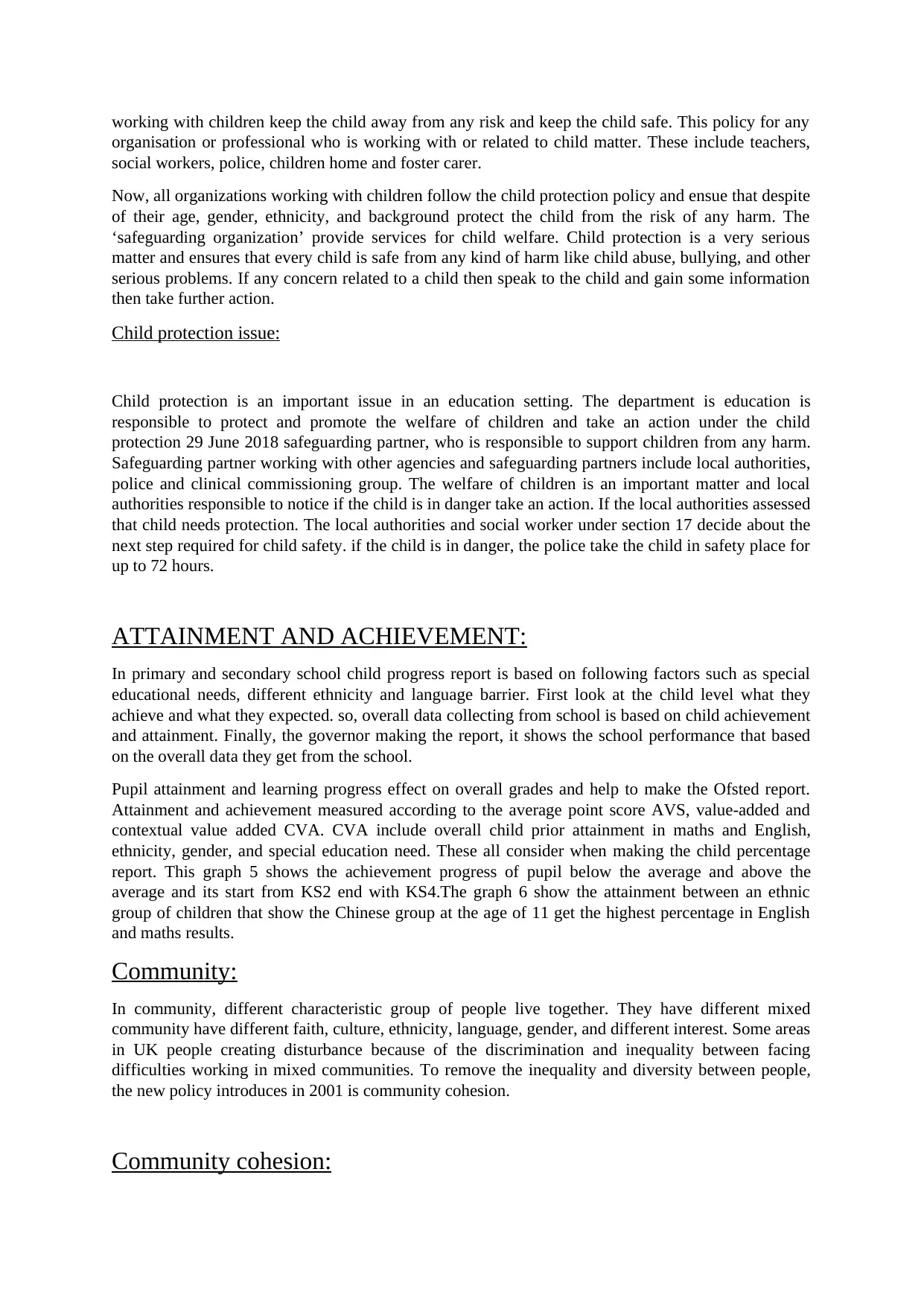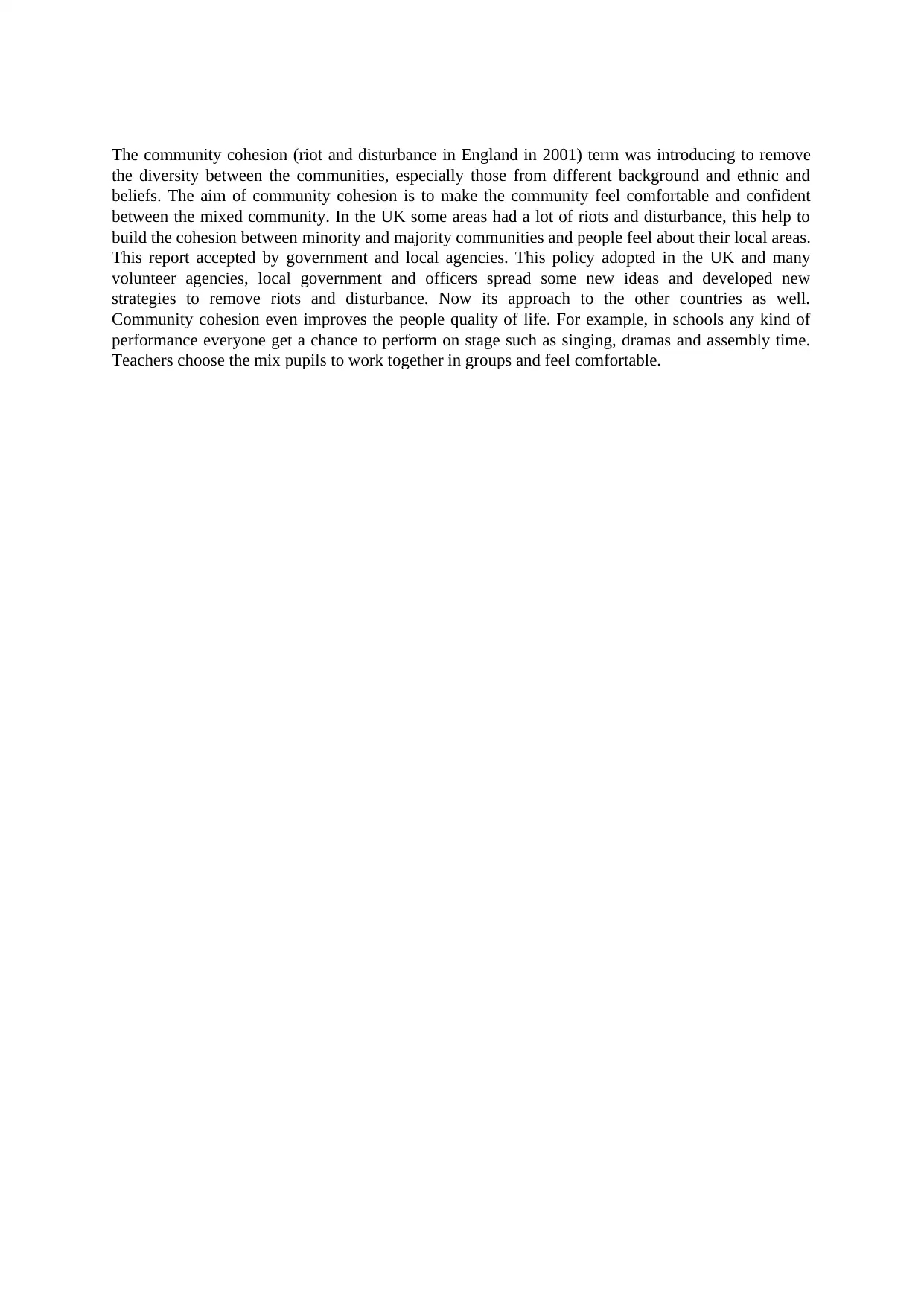Report on Educational Inequality, Policies, and Community Cohesion
VerifiedAdded on 2020/10/05
|3
|1432
|68
Report
AI Summary
This report delves into the multifaceted issue of educational inequality, examining its various dimensions and the policies designed to address it. It begins by defining educational equality and highlighting the challenges posed by societal differences, such as gender, religion, race, age, and disabilities, which often lead to discrimination and inequality. The report then explores two key sociological perspectives: Functionalism and Marxism. Functionalism emphasizes how social institutions contribute to societal well-being, while Marxism analyzes how class structures and economic disparities influence educational outcomes. The report examines the Every Child Matters policy, designed to ensure children's safety, health, and well-being, along with child protection procedures within educational settings. It further analyzes the impact of factors like special educational needs, ethnicity, and language barriers on student attainment and achievement. The report also explores the concept of community cohesion and its role in fostering inclusive environments within schools and communities, ultimately aiming to create a fair and equitable educational system.

Introduction:
The educational setting is a place where staff and students are treated fairly and where their needs and
requirements are valued. Equality in education means to be fair with all individuals so their potentials
are fulfilled without any discrimination. However, this can be challenging in a society where there are
many differences in terms of gender, religion, race, age, and disabilities and this is why issues of
inequality and discrimination such as bullying, and harassment develop. In this report I will explain
issues faced in terms of educational inequality and outline the policies and procedures that aim to
prevent and deal with these problems.
Functionalism and Marxism:
Functionalism’s (Emile Durkheim, Robert Merton a structural consensus theory) main principal is to
explain about how society and social institutions such as family, school and government legal system
can work together for the greater good. Every organisation in this society has a specific role to play in
maintaining and improving the society. In this theory, they have a consensus to build the functional
society. Everyone must work toward the common goal in society and maintain the stability and social
order in every social institute.
Marxism (Karl Marx a conflict theory) on the other hand divides society into two classes, the ruling
class and the lower or working class termed the Bourgeoisie and Proletariats class respectively.
Marx’s theory explains how the education, media and law institutions are used by the ruling society.
He explains that achieving social mobility is more difficult for the working class. Marxists believe
that due to this the elite control the working class not with physical force but with different ideas that
cause the conflict between two classes.
Economic issues produce the rich, middle and poor class. Marxist believes that the capitalization
helps to improve the economy in our society by providing education. The capitalization is important
to shape the educational system and help to improve the economy. However Marxist theory
capitalization society where inequality exists such as power, wealth and opportunities.
In our education system in school, your achievement and grade is based on your hard-work and top
qualified students get the top jobs. The cause of success and failure depend on the class of parents
because if the parents are top class, they know how children improve their marks so, they provide
more duration to stay in education (bowls and Gintis). According to the Marxist, the progress or
grades of pupil depend on the rich and poor class in society. UK government statistics report of
GCSCs exam report of lower, middle and poor threshold includes in the graph. Graph 1 shows they
vary from ever year. 21% students who are eligible for free school meal hardly managed to get 5
GCSCs out of 75% top achiever. Graph 2 show the eligibility of free school meal between different
ethnic groups. It shows percentage of British white people who are eligible for free school meal is
high.
These GCSE results are disadvantageous for the poor school results. These background issues
influence education system by not getting enough support from parents and families. Pupil who are
from poor background families give less result as compared to the pupil belonging to good families.
Every child matter:
Every child matter policy was launched in 2003. Children from any background should stay safe, be
healthy, achieve economic well-being and make positive contribution. These policies attached that are
necessary for other agencies partnership include school, community center, children center, early
year's health services and play worker. Every child matter policy cover from birth upto age 19. In
2010 under David Cameron government some movement away from every child matter 2003 when
The educational setting is a place where staff and students are treated fairly and where their needs and
requirements are valued. Equality in education means to be fair with all individuals so their potentials
are fulfilled without any discrimination. However, this can be challenging in a society where there are
many differences in terms of gender, religion, race, age, and disabilities and this is why issues of
inequality and discrimination such as bullying, and harassment develop. In this report I will explain
issues faced in terms of educational inequality and outline the policies and procedures that aim to
prevent and deal with these problems.
Functionalism and Marxism:
Functionalism’s (Emile Durkheim, Robert Merton a structural consensus theory) main principal is to
explain about how society and social institutions such as family, school and government legal system
can work together for the greater good. Every organisation in this society has a specific role to play in
maintaining and improving the society. In this theory, they have a consensus to build the functional
society. Everyone must work toward the common goal in society and maintain the stability and social
order in every social institute.
Marxism (Karl Marx a conflict theory) on the other hand divides society into two classes, the ruling
class and the lower or working class termed the Bourgeoisie and Proletariats class respectively.
Marx’s theory explains how the education, media and law institutions are used by the ruling society.
He explains that achieving social mobility is more difficult for the working class. Marxists believe
that due to this the elite control the working class not with physical force but with different ideas that
cause the conflict between two classes.
Economic issues produce the rich, middle and poor class. Marxist believes that the capitalization
helps to improve the economy in our society by providing education. The capitalization is important
to shape the educational system and help to improve the economy. However Marxist theory
capitalization society where inequality exists such as power, wealth and opportunities.
In our education system in school, your achievement and grade is based on your hard-work and top
qualified students get the top jobs. The cause of success and failure depend on the class of parents
because if the parents are top class, they know how children improve their marks so, they provide
more duration to stay in education (bowls and Gintis). According to the Marxist, the progress or
grades of pupil depend on the rich and poor class in society. UK government statistics report of
GCSCs exam report of lower, middle and poor threshold includes in the graph. Graph 1 shows they
vary from ever year. 21% students who are eligible for free school meal hardly managed to get 5
GCSCs out of 75% top achiever. Graph 2 show the eligibility of free school meal between different
ethnic groups. It shows percentage of British white people who are eligible for free school meal is
high.
These GCSE results are disadvantageous for the poor school results. These background issues
influence education system by not getting enough support from parents and families. Pupil who are
from poor background families give less result as compared to the pupil belonging to good families.
Every child matter:
Every child matter policy was launched in 2003. Children from any background should stay safe, be
healthy, achieve economic well-being and make positive contribution. These policies attached that are
necessary for other agencies partnership include school, community center, children center, early
year's health services and play worker. Every child matter policy cover from birth upto age 19. In
2010 under David Cameron government some movement away from every child matter 2003 when
Paraphrase This Document
Need a fresh take? Get an instant paraphrase of this document with our AI Paraphraser

working with children keep the child away from any risk and keep the child safe. This policy for any
organisation or professional who is working with or related to child matter. These include teachers,
social workers, police, children home and foster carer.
Now, all organizations working with children follow the child protection policy and ensue that despite
of their age, gender, ethnicity, and background protect the child from the risk of any harm. The
‘safeguarding organization’ provide services for child welfare. Child protection is a very serious
matter and ensures that every child is safe from any kind of harm like child abuse, bullying, and other
serious problems. If any concern related to a child then speak to the child and gain some information
then take further action.
Child protection issue:
Child protection is an important issue in an education setting. The department is education is
responsible to protect and promote the welfare of children and take an action under the child
protection 29 June 2018 safeguarding partner, who is responsible to support children from any harm.
Safeguarding partner working with other agencies and safeguarding partners include local authorities,
police and clinical commissioning group. The welfare of children is an important matter and local
authorities responsible to notice if the child is in danger take an action. If the local authorities assessed
that child needs protection. The local authorities and social worker under section 17 decide about the
next step required for child safety. if the child is in danger, the police take the child in safety place for
up to 72 hours.
ATTAINMENT AND ACHIEVEMENT:
In primary and secondary school child progress report is based on following factors such as special
educational needs, different ethnicity and language barrier. First look at the child level what they
achieve and what they expected. so, overall data collecting from school is based on child achievement
and attainment. Finally, the governor making the report, it shows the school performance that based
on the overall data they get from the school.
Pupil attainment and learning progress effect on overall grades and help to make the Ofsted report.
Attainment and achievement measured according to the average point score AVS, value-added and
contextual value added CVA. CVA include overall child prior attainment in maths and English,
ethnicity, gender, and special education need. These all consider when making the child percentage
report. This graph 5 shows the achievement progress of pupil below the average and above the
average and its start from KS2 end with KS4.The graph 6 show the attainment between an ethnic
group of children that show the Chinese group at the age of 11 get the highest percentage in English
and maths results.
Community:
In community, different characteristic group of people live together. They have different mixed
community have different faith, culture, ethnicity, language, gender, and different interest. Some areas
in UK people creating disturbance because of the discrimination and inequality between facing
difficulties working in mixed communities. To remove the inequality and diversity between people,
the new policy introduces in 2001 is community cohesion.
Community cohesion:
organisation or professional who is working with or related to child matter. These include teachers,
social workers, police, children home and foster carer.
Now, all organizations working with children follow the child protection policy and ensue that despite
of their age, gender, ethnicity, and background protect the child from the risk of any harm. The
‘safeguarding organization’ provide services for child welfare. Child protection is a very serious
matter and ensures that every child is safe from any kind of harm like child abuse, bullying, and other
serious problems. If any concern related to a child then speak to the child and gain some information
then take further action.
Child protection issue:
Child protection is an important issue in an education setting. The department is education is
responsible to protect and promote the welfare of children and take an action under the child
protection 29 June 2018 safeguarding partner, who is responsible to support children from any harm.
Safeguarding partner working with other agencies and safeguarding partners include local authorities,
police and clinical commissioning group. The welfare of children is an important matter and local
authorities responsible to notice if the child is in danger take an action. If the local authorities assessed
that child needs protection. The local authorities and social worker under section 17 decide about the
next step required for child safety. if the child is in danger, the police take the child in safety place for
up to 72 hours.
ATTAINMENT AND ACHIEVEMENT:
In primary and secondary school child progress report is based on following factors such as special
educational needs, different ethnicity and language barrier. First look at the child level what they
achieve and what they expected. so, overall data collecting from school is based on child achievement
and attainment. Finally, the governor making the report, it shows the school performance that based
on the overall data they get from the school.
Pupil attainment and learning progress effect on overall grades and help to make the Ofsted report.
Attainment and achievement measured according to the average point score AVS, value-added and
contextual value added CVA. CVA include overall child prior attainment in maths and English,
ethnicity, gender, and special education need. These all consider when making the child percentage
report. This graph 5 shows the achievement progress of pupil below the average and above the
average and its start from KS2 end with KS4.The graph 6 show the attainment between an ethnic
group of children that show the Chinese group at the age of 11 get the highest percentage in English
and maths results.
Community:
In community, different characteristic group of people live together. They have different mixed
community have different faith, culture, ethnicity, language, gender, and different interest. Some areas
in UK people creating disturbance because of the discrimination and inequality between facing
difficulties working in mixed communities. To remove the inequality and diversity between people,
the new policy introduces in 2001 is community cohesion.
Community cohesion:

The community cohesion (riot and disturbance in England in 2001) term was introducing to remove
the diversity between the communities, especially those from different background and ethnic and
beliefs. The aim of community cohesion is to make the community feel comfortable and confident
between the mixed community. In the UK some areas had a lot of riots and disturbance, this help to
build the cohesion between minority and majority communities and people feel about their local areas.
This report accepted by government and local agencies. This policy adopted in the UK and many
volunteer agencies, local government and officers spread some new ideas and developed new
strategies to remove riots and disturbance. Now its approach to the other countries as well.
Community cohesion even improves the people quality of life. For example, in schools any kind of
performance everyone get a chance to perform on stage such as singing, dramas and assembly time.
Teachers choose the mix pupils to work together in groups and feel comfortable.
the diversity between the communities, especially those from different background and ethnic and
beliefs. The aim of community cohesion is to make the community feel comfortable and confident
between the mixed community. In the UK some areas had a lot of riots and disturbance, this help to
build the cohesion between minority and majority communities and people feel about their local areas.
This report accepted by government and local agencies. This policy adopted in the UK and many
volunteer agencies, local government and officers spread some new ideas and developed new
strategies to remove riots and disturbance. Now its approach to the other countries as well.
Community cohesion even improves the people quality of life. For example, in schools any kind of
performance everyone get a chance to perform on stage such as singing, dramas and assembly time.
Teachers choose the mix pupils to work together in groups and feel comfortable.
⊘ This is a preview!⊘
Do you want full access?
Subscribe today to unlock all pages.

Trusted by 1+ million students worldwide
1 out of 3
Related Documents
Your All-in-One AI-Powered Toolkit for Academic Success.
+13062052269
info@desklib.com
Available 24*7 on WhatsApp / Email
![[object Object]](/_next/static/media/star-bottom.7253800d.svg)
Unlock your academic potential
Copyright © 2020–2025 A2Z Services. All Rights Reserved. Developed and managed by ZUCOL.





